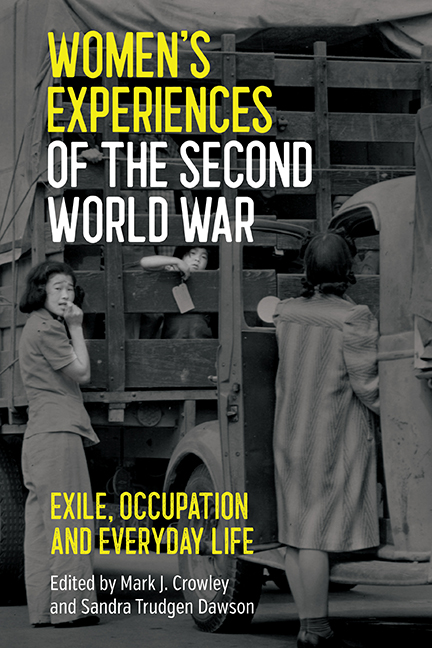Book contents
- Frontmatter
- Dedication
- Contents
- List of Illustrations
- List of Contributors
- Acknowledgements
- List of Abbreviations
- Introduction: Women’s Experiences of the Second World War: Exile, Occupation and Everyday Life
- Part One Living in Exile and under Wartime Occupation
- Part Two Living with Wartime Occupiers
- Part Three Everyday Life at Home and on the Battle Front
- Index
6 - Interracial Marriage in Occupied Japan
Published online by Cambridge University Press: 03 June 2021
- Frontmatter
- Dedication
- Contents
- List of Illustrations
- List of Contributors
- Acknowledgements
- List of Abbreviations
- Introduction: Women’s Experiences of the Second World War: Exile, Occupation and Everyday Life
- Part One Living in Exile and under Wartime Occupation
- Part Two Living with Wartime Occupiers
- Part Three Everyday Life at Home and on the Battle Front
- Index
Summary
‘Kimonoed U.S. Marine Weds Unblushing Jap Bride’, read the headline in Pacific Stars and Stripes (PSS) announcing the first marriage between a U.S. serviceman and a Japanese woman in occupied Japan. The 1946 marriage ceremony coincided with the beginning of a shift in the way the American occupiers viewed Japanese women. The front-page story in the Pacific Stars and Stripes suggests an informal approval of the union. The unblushing bride and kimonoed Marine stood as metaphors for what General MacArthur hoped would be foreign and domestic endorsement of the democratization of Japan.
However, what the article does not reveal is that the newlyweds were about to encounter obstacles that would work against their interracial union. U.S. immigration law forbade Japanese women from entering the U.S. even as the wife of a soldier. Since Japanese wives were not permitted to relocate to America, the Supreme Commander of Allied Powers (SCAP) would not officially approve the marriages. Without the blessing of the SCAP, brides were denied access to military housing, her husband's insurance and medical benefits, and his allotment checks. Lacking official approval, the groom could be denied permission to live off base with his wife. Indeed, the soldier might be forced to live in Japan as he was not allowed to bring his wife to the U.S., nor could he enroll his children in American schools.
Immigration law changed briefly in 1947 to allow Japanese wives to accompany American husbands to the U.S. Yet the legal hurdles were just one of many for interracial marriages. Issues of racial intolerance and preconceived ideas about interracial marriage shaped official policies as did gender and racial attitudes that informed public opinion in Japan and America. Using oral histories from Japanese wives of American servicemen, this chapter examines the experiences of the women who chose to marry a member of the occupying forces at the end of the Second World War.
Marriage and Paternal Authority in Pre- and Post-war Japan
In 1945, the Japanese population began a desperate search for food, shelter, and jobs. Occupation forces created a huge demand for skilled and unskilled workers and thousands of Japanese women and men filled these positions. All the women interviewed for this study worked in these jobs, often leaving families and friends to travel alone to areas where the chance of work was greatest.
- Type
- Chapter
- Information
- Women's Experiences of the Second World WarExile, Occupation and Everyday Life, pp. 95 - 112Publisher: Boydell & BrewerPrint publication year: 2021



